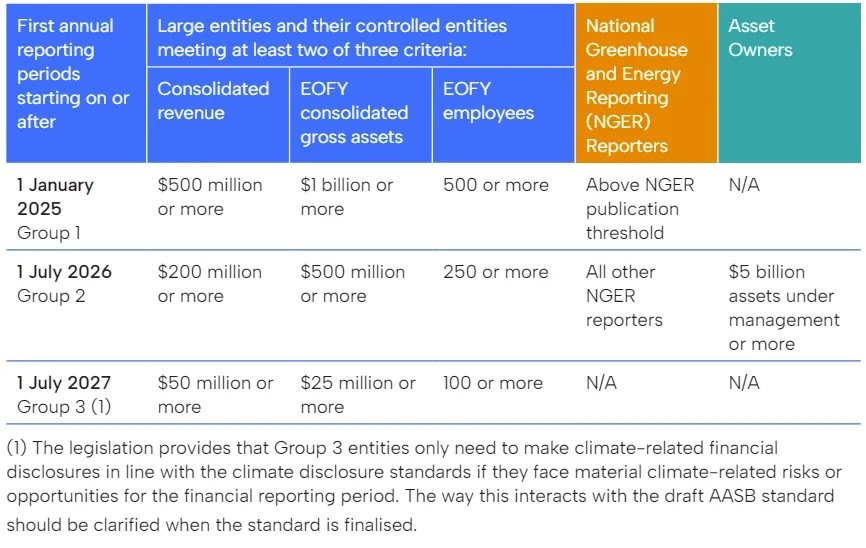Australian Mandatory Climate Reporting 101
*Note: I have received some great feedback on this article from people who have forwarded it on to their Executives, Boards and colleagues wanting/needing to get up to speed quickly, but unsure where to start.
With so many new subscribers, it’s worth sharing again, as my intention from the beginning with this piece was to create an easy-to-digest guide. Feel free to use it to embed a common commercial language internally with your team.
Has Parliament passed this bill into legislation? Yes
So this is just a compliance play? No
Have my competitors already started on their climate reporting journey? Yes
Is my company going to be impacted by this? Yes
Is my role going to be impacted by this? Yes
But you don’t know what my role is? The answer is still yes
Will this information be used by customers, employees and investors? Yes
Will I have people in my company tell me it’s not important? Yes
Are they correct? No
Ok, where do I start? Right here
Australian Sustainability Reporting Standards: A New Era of Transparency
Where did this come from? A Quick History on the International Transition:
Once the Climate-related Financial Disclosure Bill 2023 was first introduced to the Australian Parliament on February 9, 2023, there was a belief it would be signed into law within 12 to 18 months. Extended consultation periods with Industry have been prioritised to ensure consensus, which has now been achieved.
This brings Australia in line with 35 other countries who have legislated climate reporting under the Paris Agreement of keeping rising global temperatures under an increase of 1.5℃, including the UK, the European Union, Japan, Argentina, Canada, Singapore, and New Zealand, with the US also expected to begin reporting in 2025.
Edit 19th Sept, 2024: ASIC just released a deeper dive into ‘Historical development of climate-related financial disclosures’ - worth a read.
What Does This Mean For You?
With the passing of the Treasury Laws Amendment (Financial Market Infrastructure and Other Measures) Bill 2024, Australia has aligned its mandatory climate reporting with the Financial Stability Board (FSB)’s international framework. The FSB was created in response to the global financial crisis of 2008, and has classed climate change as an existential threat to the global economy. They have designed the international reporting standards (ISSB) to enhance transparency, accountability, and informed decision-making.
This alignment means Australian organisations with more than $50m in annual revenue will be required to report on their climate performance under Chapter 2M of the Corporations Act, with Group 1 commencing 1st January, 2025 and Group 3 commencing 1st July, 2027, and compliance enforced by ASIC.
What Are Groups 1, 2 & 3?
Credit: ASX
The Australian Sustainability Reporting Standards (ASRS) aim is to provide a comprehensive and consistent set of guidelines for businesses to disclose their climate risk exposure of their physical assets and the level of potential disruption to their business model based on the transition of the global economy and integrated supply chains to net zero by 2050.
How Have The ASRS Evolved?
The development of ASRS has been a collaborative effort involving various stakeholders, including businesses, investors, regulators, and civil society organisations. Recognising the global trend towards sustainability reporting and the growing investor demand for climate-related information, the Australian Accounting Standards Board (AASB) has been instrumental in driving the creation of these standards.
What Are The Key Components Of ASRS?
The ASRS framework has been designed to provide a clear and structured approach to mandatory climate-related disclosures. Given the critical importance of climate change, the ASRS framework places a strong emphasis on identifying climate risks and opportunities. It encompasses the following key elements for organisations:
Governance and risk management processes related to climate
Strategy to address climate-related risks and opportunities
Metrics and targets to assess climate performance
Greenhouse gas emissions data
Climate scenario analysis
What Are The Benefits Of ASRS?
The implementation of ASRS offers several benefits for businesses, investors, and society as a whole:
Enhanced Transparency: By providing a standardised framework for climate reporting, ASRS improves transparency and accountability for businesses and their supply chains, providing investors and other stakeholders a better understanding of a company's ESG performance and risks.
Improved Decision-Making: ASRS enables investors to make more informed investment decisions by providing access to relevant sustainability information. This can result in increased capital allocation to, and lower interest rates (green loans) for, companies with strong ESG practices over companies yet to grapple with the changing commercial landscape.
Risk Management: By identifying and addressing climate risks, businesses can proactively mitigate potential negative impacts on their operations and supply chain partners.
Stakeholder Engagement: ASRS can facilitate better engagement with stakeholders, including employees, customers, suppliers, and communities. By disclosing sustainability information, businesses can quantify their commitment to responsible practices and reap the commercial and reputational benefits of doing so.
Key Takeaways:
Start building your internal coalition and your climate gap analysis, now
The Australian Sustainability Reporting Standards represent a significant step forward in promoting sustainability and transparency in the Australian business environment
By providing a comprehensive and consistent framework for disclosing ESG information, ASRS will contribute to a more profitable and resilient economy.
Until next week,
Dan
